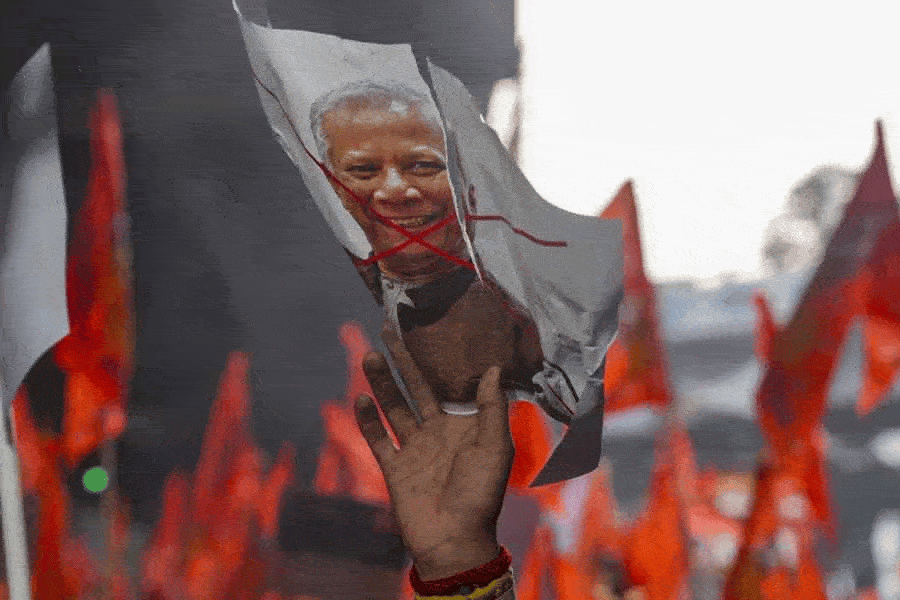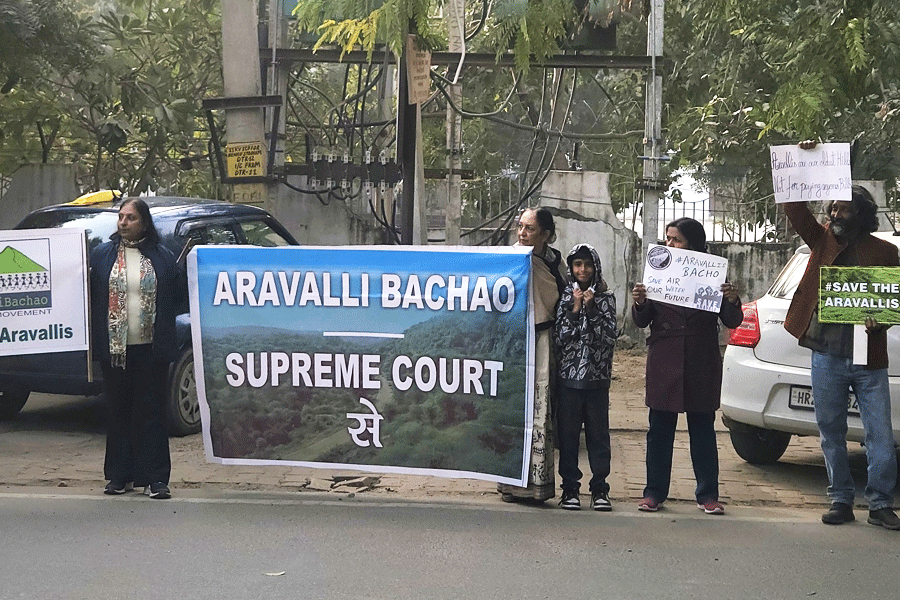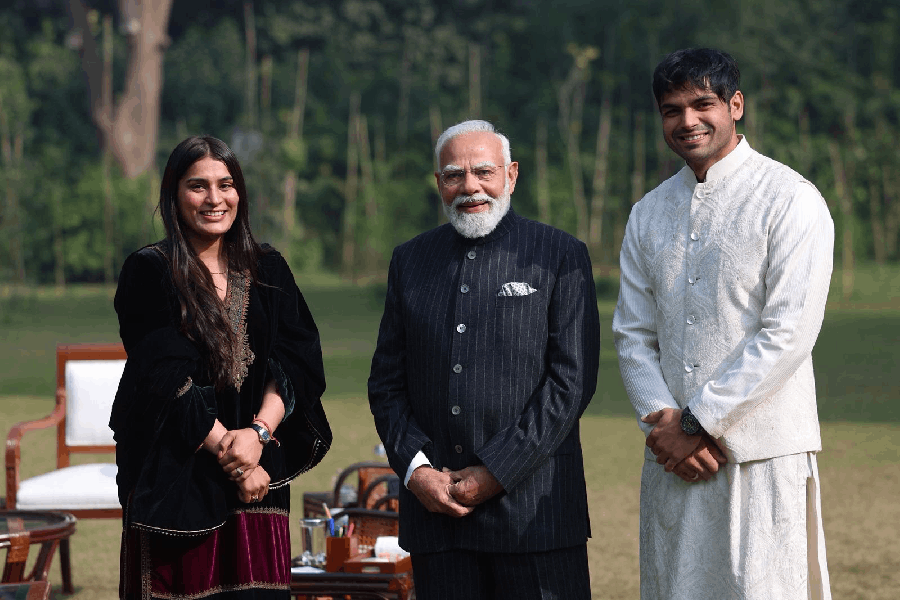 |
| Thomas Machell’s self-portrait (from British Library) done in Egypt on his Red Sea voyage home; (below) Jenny Balfour-Paul in Calcutta. Picture by Anindya Shankar Ray |
 |
Imagine bridging the divide of a century and more, and chatting with a 19th century Englishman, a midshipman, traveller and indigo planter who used to write to his father journal-style of his travels in Asia and elsewhere and also illuminate them with watercolours.
Jenny Balfour-Paul, who did her doctoral thesis in indigo in the Arab world and wrote a book on indigo worldwide for the British Museum, discovered the “Talking Papers” of Thomas Machell (1824-62) in November 1999.
Since then she has traced his route across continents to write, in the words of Machell, “a novel in the form of an autobiography”. He died too young to fulfil this ambition himself. The Machell papers were acquired by the British Library in 1980.
Balfour-Paul, now with Exeter University, was recently in town as her odyssey, which started in February 2000, came to a conclusion. She came this time to lecture at the second Sutra conference on natural dyes and textile conservation.
Balfour-Paul says she has developed a kinship with Machell, who in his day and age studied Hinduism and Islam and came to the conclusion that Christianity was not necessarily the only religion. Machell was concerned about the condition of workers, loved the Bengal countryside, promoted handloom, founded a school for poor village children, thought women were better than men and hated violence, particularly warfare and bloodsports.
He started writing letters and sketching when en route to Asia in 1840 aged 16, later gathering the material together into a 3,000-page journal. What first caught Balfour-Paul’s attention were his words that echoed her own experience: Who would have thought indigo would give me a chance to lead an interesting life, travel and meet people? He even planned to write a book on indigo. Machell also wondered out loud if someone would come across his writing in a library in the 20th century and find it of interest.
Balfour-Paul was so impressed that she changed the indigo lecture she was giving in January 2000 at London’s Royal Geographical Society to include Machell.
When Balfour-Paul came to India the following month, joined by her husband and Amrita Mukerji, the founder of Sutra, she tracked down various ruined neel kuthis (indigo plantations) in Bengal. She also travelled overland to Bangladesh, a journey that took Machell five hours on horseback.
Machell’s last factory near Jessore on the Ichhamati river had been destroyed in 1971, but she eventually discovered its headquarters in a very remote place near Bongaon, the offices and huge tanks still surviving in the jungle.
Machell may have been a nobody, who was bullied on board ship and affected by a “birth defect” of a limp, but that he had a voice and head of his own is clear from his sobriquet for Calcutta — “City of Pale Faces”. When he came to the city he usually stayed in a modest house of friends on Wellesley Street. In 2000 it had become a video shop but now that too is gone.
Machell’s journal gives vivid descriptions of life in Calcutta. For example, in one section he describes the cannon booming at Fort William to usher in 1850.
The ship in which he sailed to the city on that occasion was the Rajah and he stayed then with friends at 1 Lower Circular Road, the corner house at the Chowringhee-end near the newly erected St Paul’s Cathedral. He describes the fine houses along Chowringhee and the merchant vessels like royal frigates, and he also went to see the race course.
Machell had an eye for detail and had typically amusing comments to make on the foppish young blood of Bengal. “…But of all the gay horsemen on this occasion none amused me more than the native gentlemen who are here called Young Bengal… Their patent leather boots, smart European dress, handsome horses and English saddles contrasted strongly with their dark faces and Oriental head dress glittering with gold and jewels…”
Machell was one of those rare Englishmen to have left behind an account of his forays in north Calcutta and the accompanying illustrations in his manuscript show a pankhapuller and pulley used to keep the large rectangular pankhas or fans in motion. He shows a thakurdalan, identified as the one in the house of Akrur Datta opposite Wellington Square, now Subhodh Mullick Square.
Durga puja is still held here although the thakurdalan is screened by an apartment block that has come up in front of it.
Machell, says Balfour-Paul, witnessed the Opium War (1840-43) as a teenager, when the merchant ship he was working on was commandeered in Calcutta as a troop ship. He saw the fishing village of Hong Kong transformed in just three years into an international trading port.
His next long voyage was sailing “before the mast” round the Cape Horn to the French Polynesian islands of the Marquesas, transporting coal from Newcastle to fuel the small steamships used by the French to patrol their latest colony.
On the return journey they picked up South American guano, used as a new fertiliser. In 2002, following Machell, Balfour-Paul took a cargo ship from Tahiti to the Marquesas.
When a teenager herself in 1970, Balfour-Paul travelled home from India by sea around the Cape of Good Hope, as Machell had done several times himself.
At New Year this year, on the last leg of her Machell travels, she again journeyed by sea, this time from Southampton to Mumbai in a large freighter via the Red Sea, the same route undertaken by Machell in 1848 on wooden dhows in the company of Arab merchants.
Both Machell and Balfour-Paul had to contend with the threat of pirate attack off the coast of southern Arabia.
Machell revisited India and Calcutta several times in search of jobs. On one occasion when he could not land one, he became assistant to indigo planter James Forlong, who has been described as a “white sheep among black”.
In another adventure Machell travelled up the Indus to visit his brother in Peshawar and Kashmir. His journal ends in 1856, when Balfour-Paul thought he died. Later she discovered that he breathed his last six years later in Narasinghpore near Jabalpur.
When she returned to Calcutta in 2003 for the first Sutra conference, on trade textiles, she took the chance to search for his grave. In an abandoned and overgrown cemetery with very few graves remaining, her daughter found it just as Balfour-Paul had given up hope.
Balfour-Paul feels many parallels exist between Machell’s life and her own. Her forthcoming book will be, she says, “the opposite of biography”, because she will not distance herself from her subject.











